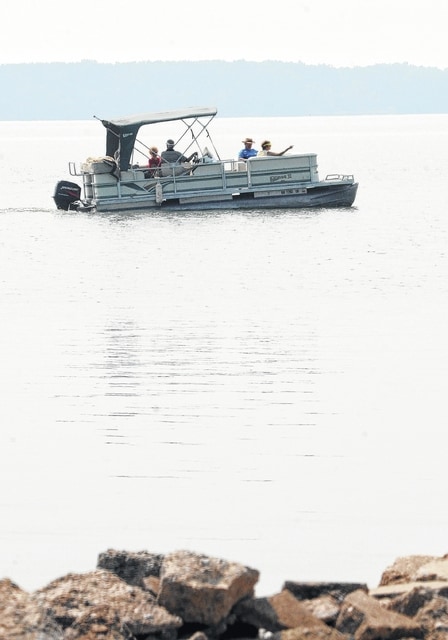
ST. MARYS — Ohio public health officials have elevated the public health advisory for Grand Lake as a result of increased levels of microcystin toxin in the 13,500-acre lake and the likely case of a person getting sick after visiting the lake.
Signs have been posted on Grand Lake public beaches and boat ramps recommending that visitors and pets avoid swimming and wading in the lake. The Ohio Department of Health reported that a visitor likely became sick from the toxin produced by harmful algae blooms.
“A local health department notified us of a visitor to Grand Lake who developed an illness after recreating on the lake,” said Dr. Mary DiOrio, medical director of the Ohio Department of Health, in a statement. “After a public health investigation, it was determined that the illness met the criteria as a probable illness due to HAB exposure, so we do not believe the lake is healthy for swimming or wading.”
Grand Lake Restoration Manager Milt Miller said the incident involved a person developing a skin rash after using a personal watercraft on the lake on June 6 and 7 on the lake. He said the lake has “enjoyed significantly increased use since the last reported health incident in 2010.
“There were no reported incidents other than this one,” he added. “We would not recommend anyone coming to the lake over their health and safety, but this isn’t as significant as it may appear.”
DiOrio confirmed that the report of the probable case came in June but that she could not discuss other specifics.
“Testing will be ongoing over the next two weeks,” DiOrio said of the lake.
She said HAB and the toxins they produce are being heavily studied because of current problems to increase what scientists know of the problem.
State health department officials said boaters are encouraged to understand the risks of exposure to higher levels of microcystin, especially if the lake shows scum, slime or resembles spilled paint. The high levels of the toxin are likely from the record rainfall this year, said Craig Butler, director of the Ohio Environmental Protection Agency, in statement.
The ODH reported microcystin levels at Grand Lake beaches recently ranged from 63.4 micrograms per cubic liter, sometimes expressed as parts per billion, to 99.6. According to the World Health Organization, there is a high relative probability of acute health effects beginning at 20.
Swallowing or coming into contact with water containing high levels of microcystin can make people sick, including rashes, hives, skin blisters, runny nose, severe diarrhea, vomiting, weakness, dizziness, abnormal liver function and difficulty breathing.
Microcystin is a toxic chemical produced by blue-green algae, which causes HABs. HABs can occur in lakes, ponds and slow-moving rivers when there are warm temperatures, sunlight, and excessive amounts of nutrients in the water. Some HABs are visible as thick mats or scum on the surface of the water, which can vary in color, including bluish-green, bright green, or even red or maroon.
Individuals who have questions about this public health advisory can call the ODH Public Information Line between 8 a.m. and 5 p.m. seven days a week at 866-800-1404. The Ohio EPA and ODH both maintain websites at http://ohioalgaeinfo.com and http://odh.ohio.gov with information on the blooms.


